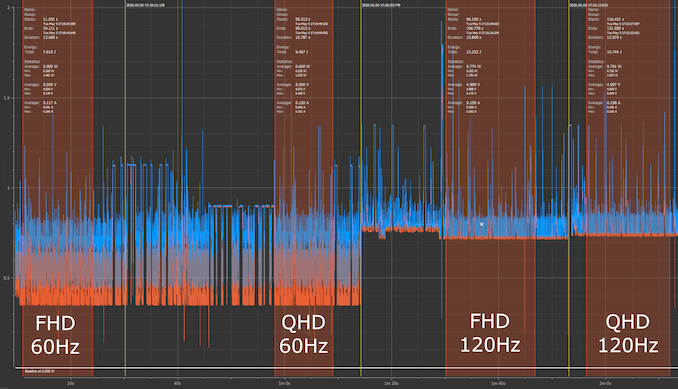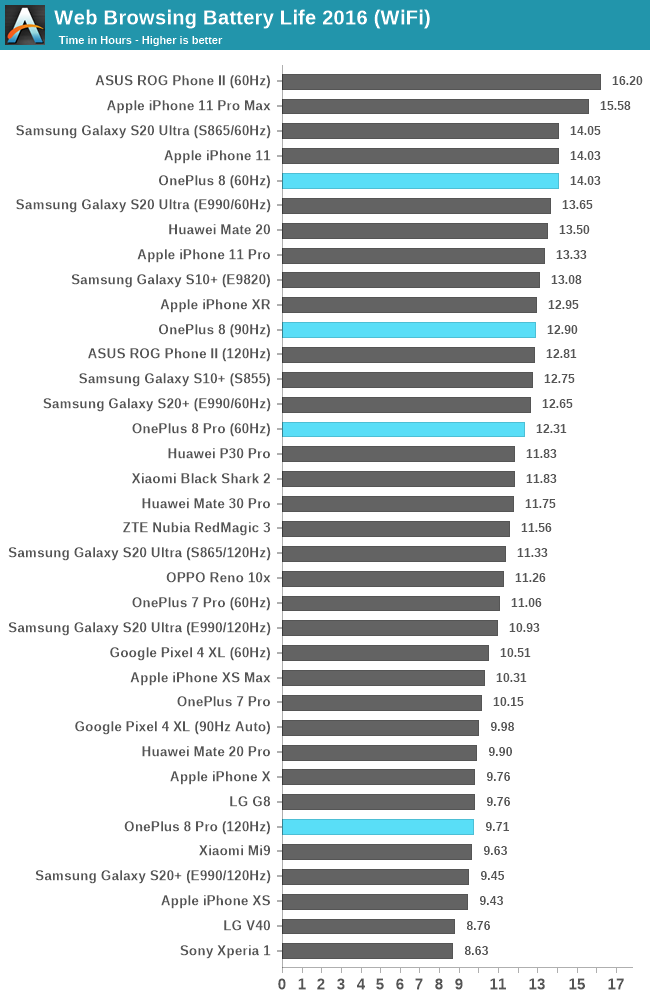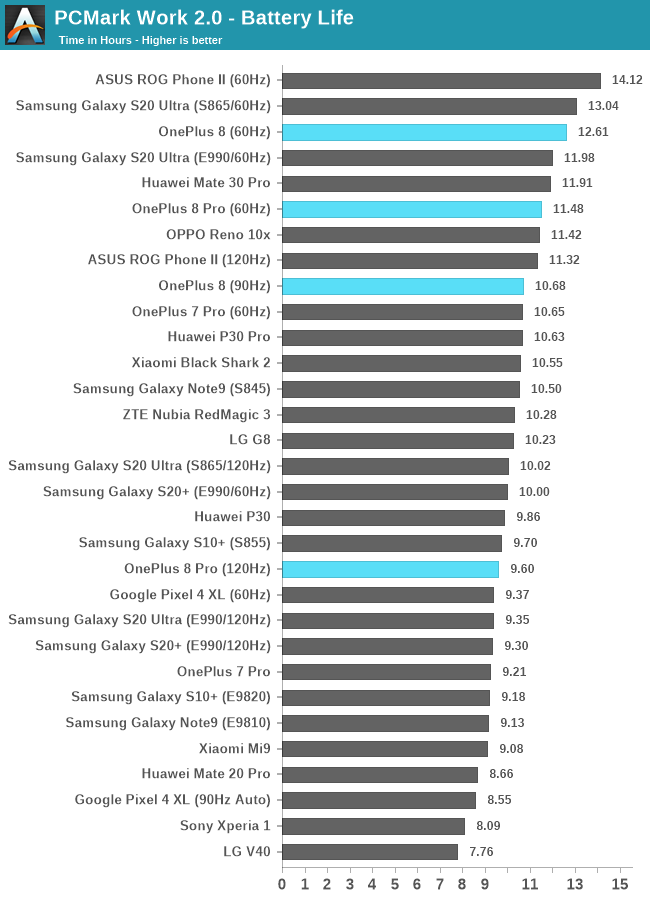The OnePlus 8, OnePlus 8 Pro Review: Becoming The Flagship
by Andrei Frumusanu on June 29, 2020 10:00 AM ESTBattery Life
Battery life of the OnePlus 8 Pro was a big question-mark for a lot of users given the phone’s 120Hz refresh rate. Several weeks ago I had reported on my initial power draw investigation results covering the different display modes of the screen:
Much like on the Galaxy S20 series, the OnePlus 8 Pro incurs a large static power draw penalty when switching from 60Hz to 120Hz. This is a increase in the baseline power of the phone, no matter the type of content that you’re displaying, and will even incur on a pure black screen.

OnePlus 8 Pro Baseline Power usage (Black Screen)
Whilst OnePlus does include refresh rate switching mechanisms based on scenarios such as video playback, the lack of a true variable refresh rate (VRR) mechanism that works on the per-frame basis and is implemented on the deeper OS and GPU driver levels, means that current generation high-refresh rate devices will have to suffer from a larger than usual power and battery life penalty.

In our web browsing test, we see the clear impact of the 120Hz refresh rate on the OnePlus 8 Pro as it reduces the battery life of the phone in the test by 22% compared to its regular 60Hz mode. As a note- we’re testing at QHD resolution here as generally there’s very little power benefit from using lower resolutions.
In terms of absolute results, the 9.71h of the 120Hz mode here are adequate but not great. The results fall in line with the S20+ at 120Hz, but short of the bigger battery capacity of the S20 Ultra. At 60Hz, the 8 Pro moves back in at 12.31h which is a great result and will get you through even the most extensive usage days.
Whilst many will have looked forward to the OnePlus 8 Pro results, the really interesting results belong to the smaller OnePlus 8. The phone here was able to showcase outstanding battery life figures. The 90Hz mode only has an 8% impact on the battery runtime in this test, and in the 60Hz mode the phone lasted for a staggering 14h which is amongst the best results we’ve ever measured on a phone.

In PCMark, the smaller OnePlus 8 again takes the lead in terms of longevity with its 60Hz mode. The 8 Pro also does quite well at 60Hz, and both phones lose respectively 15.4% and 16.4% of their runtime when switching over to 90Hz and 120Hz modes.
Whilst the OnePlus 8 Pro pretty much fell in line with what we’ve expected in terms of its battery life, falling in line with the 120Hz power behaviour of the S20 phones, it’s the regular OnePlus 8 which surprised a lot given that it features a slightly smaller battery, notably surpassing the efficiency of the OnePlus 8 Pro. Given its form-factor and weight, it’s easily the longest-lasting device of its class, with only other heavier, bigger battery phones being comparable in terms of battery longevity.










92 Comments
View All Comments
jaju123 - Monday, June 29, 2020 - link
Hi Andrei thanks for the review.Did you encounter the low brightness green tint issue on the OP8 Pro? I haven't seen any mention of it here.
Thanks
Andrei Frumusanu - Monday, June 29, 2020 - link
I didn't have the problem on my device.MrPhilo - Tuesday, June 30, 2020 - link
New update has increased minimum brightness so you would not see it anymore. Installing a custom kernel and changing the brightness to lowest you will see it.Flunk - Monday, June 29, 2020 - link
Sure, if flagship means adding a bunch of pointless features and charging too much for the phone. I think reviewers failing to take value into account in reviews have to take at least some of the blame for these crazy phone prices.Oneplus' quest to make their products irrelevant has now met its totally forseen conclusion.
BedfordTim - Monday, June 29, 2020 - link
It would be nice to see a flagship camera in something like a P30 Lite.close - Tuesday, June 30, 2020 - link
That's kind of what flagship means... Manufacturers bundle the best they have and when they run out of the good stuff they start bundling trinkets, bells, whistles, ribbons... And for most people buying the flagship isn't a matter of need but of want. They have the money, they want the image, even if many of the actual features are superfluous.I think what the title actually means is that OP started up by branding the devices as "flagship killer", the "80% flagship at 20% of the price" so to speak. With OP8 they are now "just" a flagship. As an OP owner I have a hard time justifying 700-1000E for this. That's not to say it's bad but it doesn't stand out of "the pack" (overstatement, I know) of Android flagships.
pjcamp - Tuesday, June 30, 2020 - link
I dunno. I see flagships subtracting options. You can't have expandable storage, you can't have a headphone jack, but you need to pay more to do without those things.s.yu - Wednesday, July 1, 2020 - link
Couldn't agree more!Retycint - Thursday, July 2, 2020 - link
Flagships were never meant to be good value-for-money. Not in the smartphone industry, not in the electronics industry, not ever.eastcoast_pete - Monday, June 29, 2020 - link
Thanks Andrei! I especially appreciate the section and detail on the video performance. However, that leaves me with a question: so, which phone is currently the best for video? It seems that even the so-called flagship models all have significant problems; one has artifacts, the next doesn't do a good job on stabilizing etc. So, which one is currently the leading candidate?